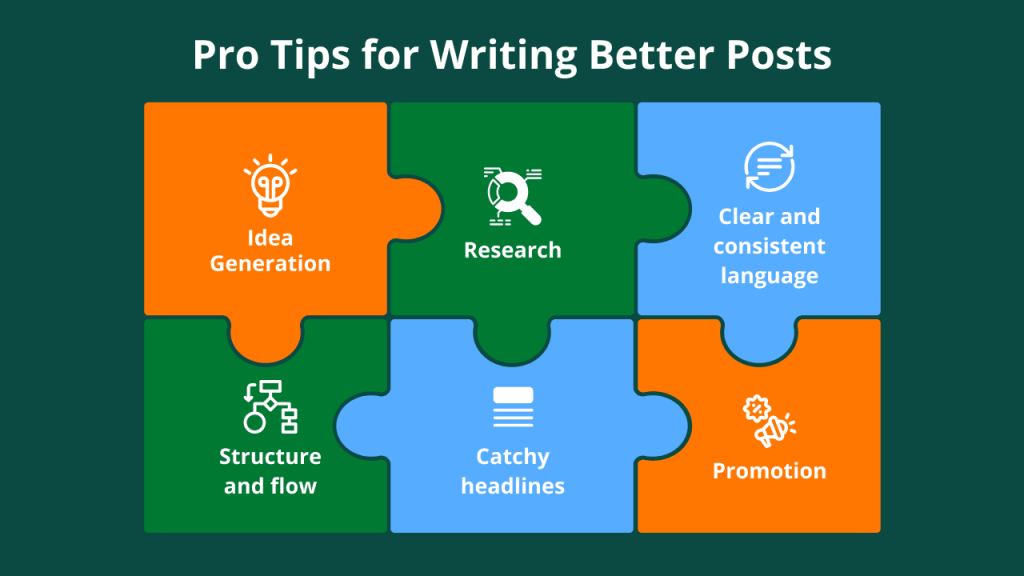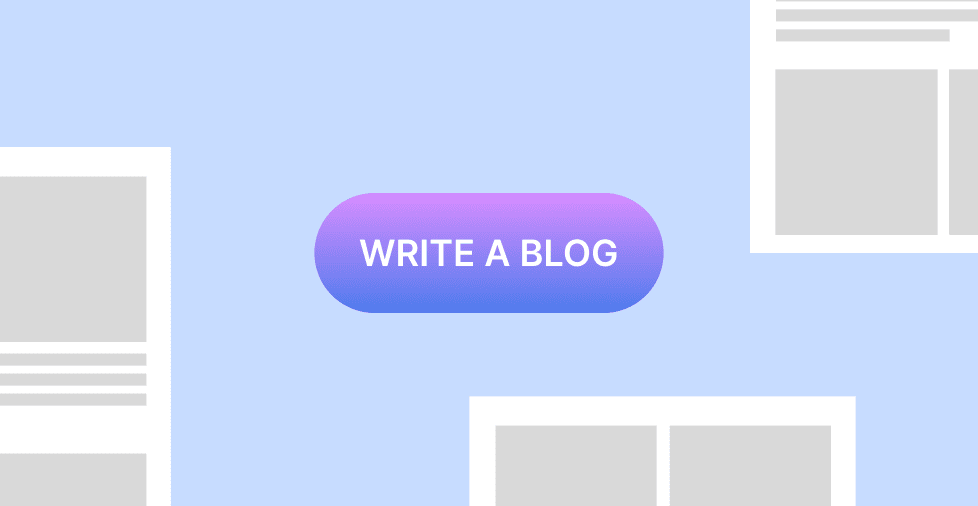Key takeaways:
- Planning your blog posts with a clear outline helps streamline writing and ensures message clarity.
- Using audience-focused language, compelling headlines, and short paragraphs improves engagement.
- Incorporating keywords naturally, optimizing headers, and adding internal links boosts SEO performance.
Writing your first blog post can feel overwhelming. There’s so much to think about: what to say, how to say it, and whether anyone will even read it.
The good news? You don’t need to be a professional writer or an SEO expert to write your first blog post. Whether you’re starting a personal blog, launching a content strategy for your business, or just exploring a new creative outlet, this guide will walk you through the process—step by step.
From choosing a topic and outlining your ideas to optimizing for search and hitting “publish,” we’ll cover everything you need to write with confidence. Let’s turn that blinking cursor into your first published post.
Elements of a great blog post
Before you start writing, it helps to understand the key elements that make a good blog post both effective and engaging. Here’s a breakdown of the components that contribute to a great post:
| Element | Why it matters |
| Clear purpose and topic | Helps you stay focused and deliver content that truly speaks to your readers’ needs. |
| Attention-grabbing title | Encourages clicks and sets expectations for what the reader will learn. |
| Logical flow and structure | Makes your post easy to read and follow, especially for skimmers and mobile users. |
| Useful, original content | Builds trust, showcases your expertise, and gives readers a reason to come back. |
| SEO best practices | Helps your blog show up in search results and attracts consistent, organic traffic. |
What is a blog post?
At its core, a blog is a way to start a conversation and an opportunity to share ideas, tell stories, or offer useful tips that spark curiosity and build genuine connections.
Whether the topic is travel, business insights, or a standout mac and cheese recipe, each blog post adds to a broader narrative and helps shape an authentic online presence.
A blog post is a crafted message designed to resonate with readers, provide value, and leave a lasting impression. When done well, it becomes a bridge between the writer and their audience.
A great blog post doesn’t need to be lengthy or overly polished. What matters most is clarity, relatability, and usefulness. When readers can sense a real person behind the words—someone who understands their interests or challenges—they’re more likely to engage, return, and trust.
For beginners, learning to translate thoughts into blog content may feel challenging at first. But with the right approach and a clear framework, it quickly becomes second nature. Each post is a stepping stone in building a voice, a brand, or a personal platform.
Before you write: Meet your audience first
Before you write a single word, get crystal clear on who will be reading your post. Ask yourself: Who am I writing for? What do they already know, and what gaps in knowledge am I trying to fill? Go beyond generic demographics—picture a real person. Are they a first-time blogger eager for step-by-step guidance?
This step-by-step guide will show you how to better know your audience so that your blog article will resonate with them.
Step 1. Define your target reader
Ask yourself: Who am I writing for? Consider their role, background, and stage in their journey. Are they a beginner seeking guidance, a small business owner looking for marketing tips, or someone switching careers in search of inspiration?
Step 2. Identify their knowledge level
Determine what your readers already know and where the gaps are. This helps you avoid talking over their heads—or oversimplifying—and ensures your content meets them right where they are.
Step 3. Pinpoint their needs and goals
What do they want to achieve by reading your blog? List their main goals, challenges, and questions. The more specific you are, the more targeted and useful your content will be.
Step 4. Create a reader persona
Sketch out a detailed profile:
- Age range
- Goals
- Challenges
- Preferred learning style (visual, written, video, etc.)
- Tone they respond to best (formal, friendly, conversational)
Step 5. Tailor your content
Once you have your persona, adjust your tone, examples, and level of detail to fit. This transforms your post from generic advice into something that feels tailor-made for your audience.
How to write a blog post in 2025: Step-by-step guide
Writing a blog post isn’t just about translating your thoughts word-for-word—it’s about connecting with readers in their own language, culture, and context. With the right approach, you can create content that feels natural, engaging, and tailored for your audience.
- Prepare before you write
- Create a clear blog outline
- Write your first draft
- Make your post easy to read
- Optimize your post for SEO
- Edit and polish before you publish
- Publish and promote your blog post
Step 1. Prepare before you write

Before you even start typing, some foundational planning will make your writing process smoother and more effective.
Choose a clear topic and focus
Choosing the right blog post topic sets the direction for your article and helps it stand out in search results. Your topic should be specific and tied to a clear intent. Are you answering a question, guiding a process, or sharing a unique insight?
Instead of a broad topic like “Marketing,” narrow it down to “How to Create a Marketing Plan for Freelancers.” This immediately clarifies the value for your reader.
Do keyword research
Understanding basic keyword research can significantly boost your post’s visibility even for beginners. This makes it easier for a search engine to match your post with user queries. You don’t need expensive tools to start.
You can use free tools, such as Google Search (look at “People also ask” and “Related searches”), Ubersuggest, and AnswerThePublic are great starting points.
Tip: For beginner guides, focus on long-tail keywords (e.g., “how to write a blog post for beginners” instead of just “blog post”). These are less competitive and often reflect specific user queries.
Step 2. Create a clear blog outline
An outline is the foundation of a strong blog post. It helps you organize your ideas, maintain a logical flow, and keep your writing focused from start to finish. Think of it as a roadmap. Breaking your post into clear parts like the introduction, body sections, and conclusion makes the writing process faster and the end result easier for readers to follow.
Pro tip: Add bullet points under each section before you start writing. This keeps your thoughts organized, prevents off-topic tangents, and ensures your key messages don’t get lost.
If you’re writing a how-to article or a list-style post, begin by identifying each main point or step. Here’s a sample structure to guide you:
How to Register a Domain Name
Briefly explain what a domain name is
- Step 1: Choose a name that fits your brand
- Step 2: Check domain availability
- Step 3: Select a domain registrar
- Step 4: Register your domain and pay
- Step 5: Set up auto-renewal and domain privacy
Outlining like this gives you a solid structure to work with, and saves time during the drafting stage. For extra support, you can also use blog post templates to help guide your layout.
Step 3. Write your first draft
Now for the fun part: expressing your ideas! Don’t worry about perfection in this stage—just focus on expressing your thoughts.
Start strong with a hook and intro
Your introduction needs to grab attention immediately.
- Ask a question: “Struggling to get your blog posts read?”
- Share a statistic: “Did you know 70% of blog readers only skim headlines?”
- Show you “get” the problem: “We’ve all been there: staring at a blank screen, wondering how to start a blog post.”
Deliver value in the body
This is where you fulfill the promise of your introduction.
- Keep paragraphs short: Aim for 2-3 sentences max.
- Use examples: Illustrate your points with real-world scenarios.
- Address pain points: Show your reader you understand their challenges and offer solutions.
End with a conclusion that motivates
Your conclusion should recap the main takeaways and provide a clear call to action (CTA). For example, you could ask them to leave a comment, share the post, or read another related article.
Write like a human, not a robot
Your voice makes your blog unique.
- Use a natural tone and don’t be afraid to use contractions.
- Avoid jargon unless it’s necessary and you explain it.
- If it fits your brand, add personality—share anecdotes, humor, or your unique perspective.
Step 4. Make your post easy to read
Even the best content can be lost if it’s hard to read. Good formatting improves clarity and skimmability.
- Use headers to break up text. Headers provide structure and guide the reader. H2s signify main points, while H3s introduce details within those points.
- Keep sentences and paragraphs short. Long blocks of text are intimidating. Break them up. A good rule is to aim for 2-3 lines max per paragraph.
- Add bulleted and numbered lists. Lists are fantastic for breaking down complex information or presenting multiple items clearly.
- Use images, graphics, or screenshots. Visuals can enhance understanding and break up text. Include them when:
- You’re showing a step-by-step process
- Conducting product reviews
- Presenting data or charts
- Write mobile-first. Most people will read your blog post on their phone. Always preview how it looks on mobile devices to ensure it’s easy to navigate and read.
Step 5. Optimize your post for SEO
Even as a beginner, understanding basic on-page SEO can help more people find your valuable content.
Place your keywords naturally
Integrate your primary keywords in critical areas like your title, introduction, headers, and conclusion. Don’t stuff them; make sure they flow naturally.
Write a compelling title tag and meta description
These are what show up in search results. Your title tag should be catchy and include your main keyword (e.g., “How to Write a Blog Post (Beginner Guide)”). Your meta description is a summary that encourages clicks.
Use internal links
Link to other relevant posts on your blog. This helps readers discover more of your content and signals to search engines that your site has valuable, interconnected information. Examples include linking to articles on “how to start a blog,” “blog SEO checklist,” or “blog post ideas.”
Add alt text to images
Alt text describes your images for visually impaired users and helps search engines understand what your images are about.
Use clean, readable URLs
Keep your URLs short and descriptive, and include your main keyword (e.g., yourwebsite.com/how-to-write-blog-post).
Step 6. Edit and polish before you publish
A good draft becomes a great post with careful editing.
- Check flow and clarity. Read through your entire post. Does it make sense? Is the argument logical?
- Fix grammar, spelling, and filler. Typos erode credibility. Use tools like Grammarly or Hemingway App to catch mistakes and identify overly complex sentences or filler words.
- Read aloud or preview in blog editor. Reading your post out loud can help you catch awkward phrasing. Previewing it in your blog editor gives you a final look at how it will appear to readers.
- Get a second set of eyes if possible. Another person might spot errors or areas for improvement that you missed.
Step 7. Publish and promote your blog post
Congratulations! You’ve written your blog post. Now, it’s time to get it in front of readers.
Promote on social media and email
Don’t just hit publish and forget it. Share your new post on your social media channels and send it to your email list.
Here’s a sample distribution checklist:
- Tweet about it
- Share on Facebook/LinkedIn
- Create an Instagram story linking to it
- Include it in your following newsletter
Repurpose for more traffic
Get more mileage out of your content by transforming it into other formats:
- Turn key points into a short video (e.g., a Reel)
- Create an infographic
- Develop a SlideShare presentation
Track performance over time
Keep an eye on key metrics to understand what resonates with your audience.
- Pageviews. How many people are seeing your post?
- Time on page. Are they reading it thoroughly?
- Shares and comments. Is it engaging your audience?
Update older posts regularly
Content isn’t static. Review older posts to add new links, refresh statistics, or expand outdated sections to keep them fresh and relevant.
What makes a blog post worth reading?
A truly valuable blog post puts the reader first. It’s not about hitting a specific word count or cramming in keywords; it’s about providing genuine value.
Good blog posts aim to educate, solve a problem, inspire, or even rank well in search results to reach a wider audience.
Think about high-performing posts. They succeed because they directly address their audience’s needs with clear, actionable information.
Final tips for writing better blog posts
Writing is a skill that improves with practice.
- Be consistent, not perfect. It’s better to publish regularly than to wait for a flawless post.
- Learn what your audience responds to. Pay attention to your analytics and comments. What topics do they love? What format performs best?
- Keep improving each post. Use what you learn from one post to make the next one even better.
Your next steps to writing great blog posts
You now have a comprehensive guide to writing effective blog posts, from planning to promotion. The key is to start, learn, and iterate.
You don’t need to be a professional writer to create a blog post that connects with readers. Anyone can turn ideas into engaging content with a clear topic, some structure, and a few formatting tricks. And once you’ve written one, it gets easier with every post.
If you’re ready to take your blog live, the right tools can make all the difference. Network Solutions offers everything you need to build a professional online presence—from custom domains and reliable hosting to easy-to-use website builders. Whether you’re starting fresh or adding a blog to your existing site, we’ve got you covered.
Frequently asked questions
Yes, many bloggers earn money through various income streams. Common methods include display advertising, affiliate marketing, sponsored content, selling digital products or services, and offering memberships or online courses.
While income levels vary widely, consistent blogging combined with a solid content strategy can generate meaningful revenue over time. Success often depends on niche selection, audience size, and how effectively a blog is monetized.
While the exact number can vary, a standard seven-step process includes:
Planning and research (topic, keywords, audience)
Outlining your content
Writing the first draft
Formatting for readability
Optimizing for SEO
Editing and proofreading
Publishing and promoting
There’s no strict rule. The ideal length depends on your topic, audience, and goals. Aim for as long as necessary to provide comprehensive value, but no longer. Some quick tips might be 500 words, while in-depth guides can be 2,000+ words. Focus on quality over quantity.
Yes! While not every single post needs to be heavily optimized, understanding basic SEO helps your posts get found by more people through search engines. It’s a key way to attract organic traffic and grow your audience over time.
Don’t worry! Everyone starts somewhere. Focus on clear communication and providing value. Practice makes perfect, and tools like Grammarly can help refine your writing. The most important thing is to start.
Yes, AI tools can be helpful for brainstorming, outlining, or even drafting sections of your blog post. However, always ensure you edit and add your unique voice and expertise. AI should be a co-pilot, not the sole author.




